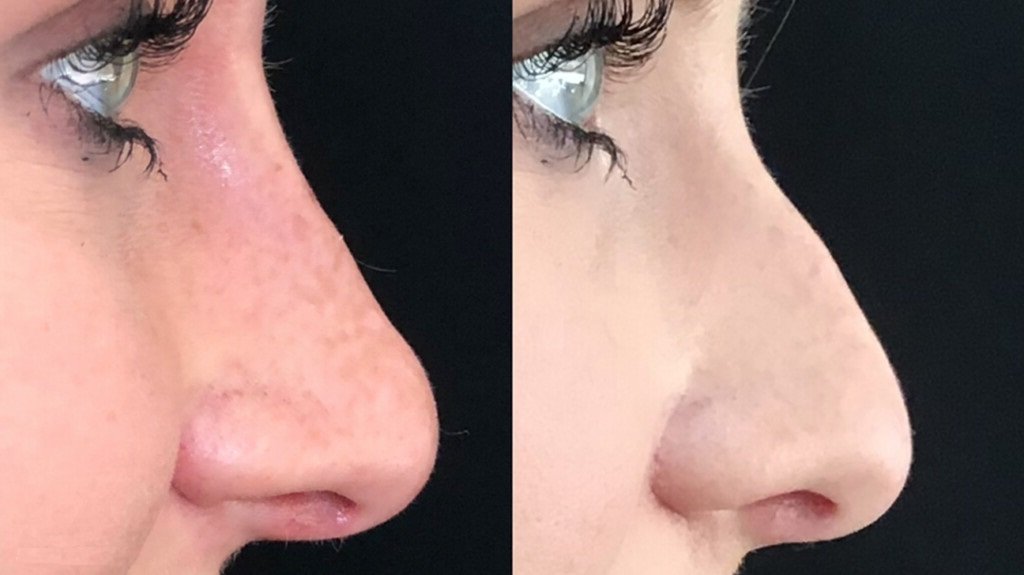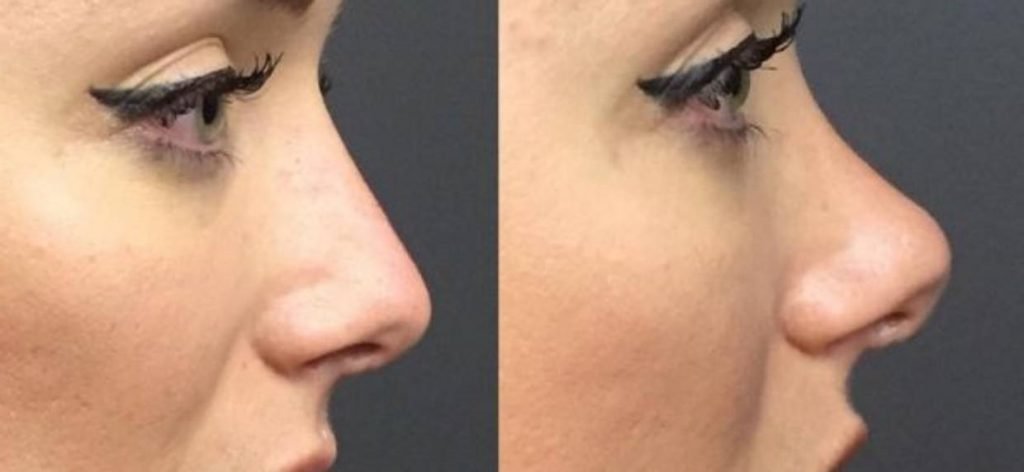Quick facts
About:
- Also known as liquid rhinoplasty or nonsurgical rhinoplasty
- This procedure involves injecting a filler substance, such as hyaluronic, beneath your skin to temporarily alter your nose’s structure.
Safety:
- Although there may be complications, this method of rhinoplasty has been deemed safe and effective by plastic surgeons.
- Redness is an often-occurring side effect.
Convenience:
- Nonsurgical rhinoplasty can be done outpatient and is far more convenient than surgical alternatives.
- A trained provider can complete the procedure in less than 15 minutes.
- You may be able to return to work in some cases the next day.
Cost:
- Nonsurgical rhinoplasty can be much more affordable than traditional rhinoplasty.
- It could cost anywhere from $600 to $1500.
Efficacy:
- Drs and patients report satisfaction with nonsurgical rhinoplasty.
- It is important to note that these results typically last six months or less.
What is nonsurgical rhinoplasty?
You might have heard of nonsurgical rhinoplasty, which is also called the “liquid nose job” or the “15-minute nose job.” It’s a dermal filler procedure that can change the shape and appearance of your nose for as long as 6 months.
This procedure is great for people who wish to smoothen out bumps on their nose or reduce their angularity but don’t want a permanent solution or are concerned about the recovery time and risks involved in traditional rhinoplasty.
While it’s easier to go under the needle for a nose job than under the knife, altering the shape of the nose is not always easy. This article will explain the procedure, costs, recovery, as well as the pros and cons of liquid rhinoplasty.
How much is it?
Nonsurgical Rhinoplasty is not covered by insurance. There’s no medical reason for recommending this procedure.
The cost of your filler, provider, and the number of injections will all affect the price. Your provider should provide a detailed breakdown of costs after your consultation to help you understand what to expect.
The American Society of Plastic Surgeons estimates you will pay between $600 and $1,500.
How does this work?
Nonsurgical Rhinoplasty uses dermal filler substances to alter the shape and appearance of your nose.
An injectable ingredient gel-like (usually Hyaluronic Acid) is placed under your skin where you want to create smoother lines and volume. Botox may also be used.
The filler ingredients settle in the deeper layers of your skin, and it holds their form. This can transform the appearance of your nose from 4 months to 3 decades, depending on the ingredients used and your skin.
How does it work?
Liquid Rhinoplasty is much simpler than surgical rhinoplasty.
After an initial consultation, where you and your doctor discuss your goals, your doctor will ask you to lie down on your back with your face up. The doctor may apply a topical anesthetic to your nose and surrounding areas so that you don’t feel the pain.
After the anesthetic has taken effect, your doctor will inject filler in the area around your nose. The procedure may cause some discomfort or slight pressure.
The entire process can take anywhere from 15 to 45 minutes.
Targeted areas
The bridge, tip, sides, and top of your nose are all treated with nonsurgical rhinoplasty. To modify the shape of any part, you can inject fillers around your nose.
This method works well if:
- You can smoothen small bumps on the nose
- Increase the prominence of your tip of the nose
- Your nose will look bigger
- Lift your nose tip
A slight bump at the bridge of the nose can be camouflaged and smoothen the nose’s contour.
Liquid rhinoplasty won’t give you the desired results if you want to reduce the nose size or smooth out prominent bumps.

Side Effects and Risks
Liquid rhinoplasty’s most common side effect is reddening the injection site within a day or so.
You might also experience the following side effects:
- An area of injection that is bruised
- Swelling
- Filler migration refers to the injection ingredient moving to other nose areas or under the eyes. It can cause a “wavy” or “overfilled” appearance.
- nausea
The nose is sensitive. The nose is sensitive because it’s close to your eyes and full of blood vessels. Liquid rhinoplasty is more complex than other injectable filler procedures.
An experienced and skilled plastic surgeon will be more inclined to fill your nose with less filler than overfilling it.
In one case, complications were more likely rested a source to arise when an unlicensed provider attempted this procedure. These are possible serious complications:
- tissue death
- Vascular complications
- vision loss
A 2019 study of 150 people with nonsurgical nose jobs found that 1.82%Trusted Source only had one complication. Talk to your doctor immediately if you experience any of these symptoms.
- Fever
- Blurred vision
- Redness and bruising that spreads rapidly and gets worse
- hives, or other symptoms of an allergic reaction
What can you expect from treatment?
Liquid rhinoplasty can cause pain, swelling, and redness at your injection site. After an hour, the injection should begin to settle. You will be able to see your desired results better once the redness stops.
You can bring an ice pack to use at home after your appointment. Please discuss with your doctor whether it is okay to use it to reduce inflammation and redness.
In a matter of weeks, the total effect should be visible. The redness and bruising should disappear by this time.
Liquid rhinoplasty is an excellent option for people who don’t mind a little downtime. You can go back to work or your usual activities in a matter of hours.
Most filler ingredients will dissolve within 6 months. Some filler ingredients may last up to 3 years. A liquid nose job isn’t permanent, no matter how long it takes.

Preparing for treatment
Different filler materials have different procedures. Your provider will give you specific instructions about what to do prior to a nonsurgical rhinoplasty.
These are just a few suggestions.
- Avoid taking anti-inflammatory medication such as ibuprofen, aspirin, vitamin E supplements, and other blood-thinning medications for at least one week before your procedure. Your doctor should know if you take any blood-thinning medications.
- You can reduce the likelihood of bruising by being aware of your vitamin levels. To increase your vitamin K intake in the weeks prior to your procedure, consume lots of green leafy vegetables.
- Eat a healthy meal and drink plenty of water before your appointment. Avoid eating too much, as you might feel nauseated after or during your appointment. Make sure to eat food with protein and starch.
Nonsurgical and traditional rhinoplasty
Nonsurgical Rhinoplasty is only for those who want to try out small modifications to their noses.
Traditional rhinoplasty might be a better option for you if you are looking to make dramatic changes to your nose.
There are pros and cons to nonsurgical rhinoplasty
- The nonsurgical option for rhinoplasty can be done without going under general anesthesia.
- You will experience a rapid recovery.
- This procedure will allow you to return to work and continue your regular activities within the same day or the next day.
- You can expect results to fade over time, but it is possible to get your fillers back.
- Nonsurgical Rhinoplasty is more affordable than traditional rhinoplasty.
Nonsurgical Rhinoplasty: The Cons
- This may not be the right procedure for you if your goal is to have a drastic and permanent transformation in your appearance.
- There may be side effects such as swelling and bruising.
- A misplaced needle can cause visible bleeding under your skin or even damage your vision.
- Since this procedure is relatively new, long-term side effects have not been well studied.
- All costs are not covered by insurance.
Traditional Rhinoplasty: The pros and cons
- The traditional rhinoplasty is bold and permanent.
- The results will be “re-upped” or refreshed in no time.
- This procedure isn’t new. Therefore, this procedure’s side effects and possible complications are well researched and well understood.
- Get insurance coverage if you have a similar medical issue, such as breathing problems.
Traditional Rhinoplasty: Cons
- If you are unhappy with the outcome, you have no other option than to wait for it to heal and go back for another rhinoplasty.
- The procedure is performed under general anesthesia in a hospital.
- There are greater chances of complications such as infection.
- It’s significantly more costly than nonsurgical Rhinoplasty.
Where to look for a provider
If you are looking for nonsurgical rhinoplasty, don’t look for a provider with little experience.
An experienced plastic surgeon can help you achieve your desired results while minimizing any side effects.
Use the American Society of Plastic Surgeons Database tool to search for board-certified plastic surgeons in your region.

